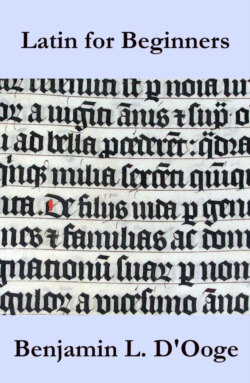Читать книгу Latin for Beginners - BENJAMIN L. D’OOGE - Страница 29
На сайте Литреса книга снята с продажи.
LESSON V
ОглавлениеFIRST PRINCIPLES (Continued)
[Special Vocabulary]
NOUNS
«corō´na», wreath, garland, crown fā´bula, story (fable) «pecū´nia», money (pecuniary) «pugna», battle (pugnacious) «victō´ria», victory
VERBS
«dat», he (she, it) gives nārrat, he (she, it) tells (narrate)
CONJUNCTION[A]
«quia» or «quod», because
«cui» (pronounced co͝oi, one syllable), interrog. pronoun, dat. sing., to whom? for whom?
[Footnote A: A conjunction is a word which connects words, parts of sentences, or sentences.]
«41.» «The Dative Case.» In addition to the relationships between words expressed by the nominative, genitive (possessive), and accusative (objective) cases, there are other relationships, to express which in English we use such words as from, with, by, to, for, in, at.[1]
[Footnote 1: Words like to, for, by, from, in, etc., which define the relationship between words, are called «prepositions».]
Latin, too, makes frequent use of such prepositions; but often it expresses these relations without them by means of case forms which English does not possess. One of the cases found in the Latin declension and lacking in English is called the dative.
«42.» When the nominative singular ends in «-a», the dative singular ends in «-ae» and the dative plural in «-īs».
NOTE. Observe that the genitive singular, the dative singular, and the nominative plural all have the same ending, «-ae»; but the uses of the three cases are entirely different. The general meaning of the sentence usually makes clear which case is intended.
a. Form the dative singular and plural of the following nouns: «fuga», «causa», «fortūna», «terra», «aqua», «puella», «agricola», «nauta», «domina».
«43.» «The Dative Relation.» The dative case is used to express the relations conveyed in English by the prepositions to, towards, for.
These prepositions are often used in English in expressions of motion, such as She went to town, He ran towards the horse, Columbus sailed for America. In such cases the dative is not used in Latin, as motion through space is foreign to the dative relation. But the dative is used to denote that to or towards which a benefit, injury, purpose, feeling, or quality is directed, or that for which something serves or exists.
a. What dative relations do you discover in the following?
The teacher gave a prize to John because he replied so promptly to all her questions—a good example for the rest of us. It is a pleasure to us to hear him recite. Latin is easy for him, but it is very hard for me. Some are fitted for one thing and others for another.
«44.» «The Indirect Object.» Examine the sentence
«Nauta fugam nūntiat», the sailor announces the flight
Here the verb, «nūntiat», governs the direct object, «fugam», in the accusative case. If, however, we wish to mention the persons «to whom» the sailor announces the flight, as, The sailor announces the flight «to the farmers», the verb will have two objects:
1. Its direct object, flight («fugam») 2. Its indirect object, farmers
According to the preceding section, to the farmers is a relation covered by the dative case, and we are prepared for the following rule:
«45.» RULE. «Dative Indirect Object.» The indirect object of a verb is in the Dative.
a. The indirect object usually stands before the direct object.
«46.» We may now complete the translation of the sentence The sailor announces the flight to the farmers, and we have
«Nauta agricolīs fugam nūntiat»
